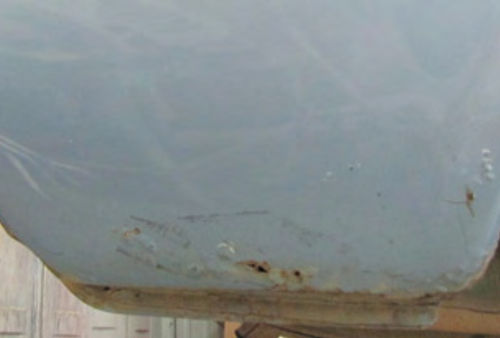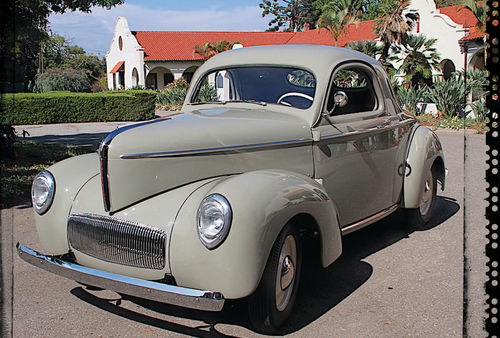Restoring a steering wheel
ARE YOU TIRED OF GRIPPING the crusty, unsightly, old steering wheel in your classic, but you’re stumped when it comes to restoring its former luster? There’s no reason to be baffled, because steering wheel restoration is not that difficult. There actually are a couple of approaches you can take, depending on how much effort, or money, you want to put into the task, and depending on the condition of your steering wheel. There are companies that specialize in recasting steering wheels in new plastic. They will take this on regardless of the condition of your old wheel. These services charge in the neighborhood of $300 to $400 on average, and can do an excellent job. The only disadvantages to having your steering wheel recast are the cost and that you may not be able to get it done in the color you need.
If chunks of your steering wheel are missing, and the reinforcing bar is showing in some areas, you probably won’t want to try to fix your wheel yourself. If that is the case, you have a couple of choices. You can either find another wheel in better shape and restore that one, or you can have your old wheel recast. On the other hand, if your wheel is just dried, faded and cracked in a few places, you can easily and inexpensively fix it yourself. Here’s how:
Remove the Wheel Study a shop manual or assembly manual for your car to learn exactly how the steering wheel is attached and how the horn works. The horn wire usually runs through the steering column and out through a hole at the bottom near the steering box where it connects indirectly through its wiring to the battery. Open the hood and disconnect the horn wire at the base of the steering column. Next, turn the horn button in the center of the steering wheel about a quarter turn clockwise to release it from its bezel. Pull the button and its wire out through the steering wheel. Remove the horn ring, if there is one. Often the horn ring is secured from behind by bolts, through the back of the steering wheel. Put any small parts, such as springs, bolts and nuts, in a plastic bag and label it so you won't misplace these hard-to-replace items. It’s a good idea to tape frail horn rings to a piece of plywood to avoid damaging them while they are off the car. Also, this is a good time to send the horn ring, horn button and any other bright trim out to be replated if they need it. If they don’t need replating, shine them up with a non-abrasive product such as Nevr-dull.
Mark the steering column with a punch or a crayon and make a corresponding mark on the base of the steering wheel so you can reorient it correctly. Otherwise, when you reinstall your restored wheel you may find the spokes at a peculiar slant, making it look like you are going around a corner when you are going straight. For your marks to be useful it is important that your car remain stationary with no movement of the front wheels while you are performing your steering wheel restoration, so be certain to set your emergency brake.
Pull the steering wheel off of its splined steering shaft using a steering-wheel-puller. Steering-wheel pullers are inexpensive and are available at tool stores and auto supply stores, Or you Can sometimes rent them at tool yards. To use a steering wheel-puller, first find which of the puller’s bolts thread into your particular wheel, then slip them through the puller yoke and screw them securely into place in the wheel.
Make sure its center shaft is lined up properly with the steering column, then slowly tighten the center shaft of the wheel puller. Be careful and work slowly, because steering wheels can come off with a lot of force and give you an upper-cut you won't forget. To add a measure of protection, wrap a small safety chain through the spokes of the wheel and then around the mount that holds the steering column to the dash before you remove the wheel.
Clean It Up
Wash your wheel with a strong solution of dish washing detergent to remove any grease or dirt. Use a small, coarse, triangular file or a Dremel motor tool and grinding bit to open and clean the cracks in the wheel. This will remove any remaining dirt and prepare a good bonding surface for the filler.

Fill the Cracks
You can use two-stage epoxy to fill in the gaps, or you can use automotive plastic filler, often referred to by the brand name, Bondo. As the accompanying photos attest, after years of routine use, I have had no problems with the durability of steering wheels I have repaired using ordinary plastic filler. Mix the filler carefully according to the instructions on the can, and only mix enough to fill a couple of cracks at a time. Over-fill the cracks. Then, when the filler sets to the consistency of cheese, sand it to shape with 80-grit, open-coat sandpaper. Setting time can vary a great deal depending on the temperature, so keep a close eye on your project.
It’s not a good idea to fill all of the cracks before sanding the filler to shape because the filler, once it sets up, will probably be harder than your steering wheel, making shaping very difficult. Just keep filling and shaping, a couple of cracks at a time, until you have all of the cracks filled. At this point you can sand the whole wheel using 360-grit dry sandpaper to eliminate any minor imperfections. Don’t try to wet sand at this point, because most plastic fillers are not waterproof. (The Eastwood Co. has a waterproof filler that can be wet-sanded.)

Paint It to Match
Remove a knob or other accent item from your car’s dash that is the same color the wheel is supposed to be. Take it to your local automotive paint supplier and have a color match made with acrylic enamel. You won’t need much paint to do your wheel, so buy the smallest container you can get, which probably will be a quart. Keep the excess on hand for later touch-up work. Also, pick up the smallest containers you can find of a cleaner such as DuPont’s Prepsol, a primer, clear coat, a flexing agent used for plastic bumpers, and anti-fisheye solution. You'll also need about four sheets of 1200-grit sandpaper.
@Media-sm-15142
Be sure to buy your primer, paint and clear coat from the same paint system such as PPG, DuPont or R&M. Mixing brands can cause problems like crazing, clouding and wrinkling because the products are often chemically different from one another. Mix primers and paints following the manufacturer’s instructions. Before you start painting, wipe your wheel down one final time with a Prepsol type cleaner to remove any oily fingerprints. Then go over it lightly with a tac rag to remove any dust.
Using a spray gun, shoot on a couple of coats of primer and let it dry thoroughly, a process that only takes a few minutes, then sand carefully with 360-grit paper to prepare the surface of your wheel for paint.
Things You'll Need
Steering Wheel Puller
Prepsol degreaser
Dremel or small triangular files
#80, #360, #1200 wet sandpaper
Plastic filler (Bondo)
Compressor and spray gun
Acrylic enamel in matching color
Compatible primer, flexing agent, anti-fisheye solution
Tac rags
Wipe the wheel again lightly with a tac rag to remove any grit. Next, mix enough paint to shoot the wheel (about half a spray gun’s paint pot), and don’t forget to add the flexing agent and the anti-fisheye solution according to the directions on these products. Then begin by shooting on a mist, or tack coat. Just spray on a light fog and give it a couple of minutes to get sticky.
The tack coat is beneficial because it will reduce the danger of runs in the final coat. Shoot the paint: on evenly, and be sure you cover every area. (If you are a novice at spraying

paint, you may want to practice on old tin cans until you get the hang of it. Don’t worry, you’ll have enough paint for a practice session and your wheel as well. Shooting cans is a good way to practice for your wheel project because it gives you experience with curved surfaces. One thing to keep in mind when shooting a curved object is you must maintain a consistent distance between the gun and the painted surface to get an even finish. In this instance, the distance from the tip of your thumb to the tip of your pinky is a good measure. Also, remember to prime the cans first so the paint will adhere as it would on the steering wheel.)
After your wheel has been painted, let it cure for the amount of time specified by the manufacturer. Then, if you have used a non-metallic pigment, use 1200-grit sandpaper dipped in water to color sand the wheel before spraying on the clear coat.
If your wheel was shot with a metallic paint don’t color sand it because you will make streaks in it if you do. Instead just shoot a clear coat over the paint according to the paint supplier’s specifications. Let your wheel dry and harden for at least five days before installing it in your car.

Line up your steering wheel with the marks you made when you removed it; or if you neglected to mark it, make sure your car’s front wheels are pointing straight ahead before pushing the wheel onto the spline. Be sure to tighten the large nut holding the wheel in place to the correct specification using a torque wrench. This must be done carefully for safety reasons.
Allow your wheel about six to eight weeks to cure before waxing it. That way, all of the gasses produced by the drying process will have time to escape and the paint will have had time to stabilize and harden.
















